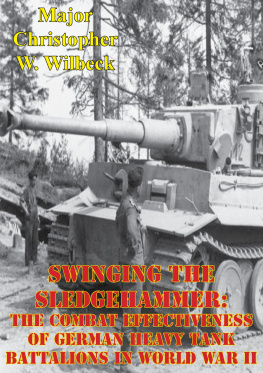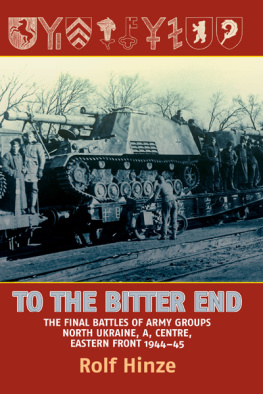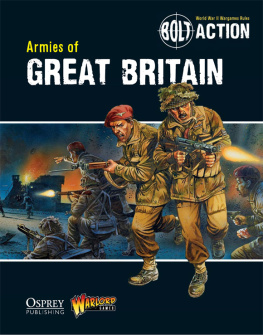CONTENTS
WHAT IS THIS BOOK?
Soldiers of the 269th Infantry Division hunting T-34s, by Peter Dennis Osprey Publishing Ltd. Taken from Campaign 148: Operation Barbarossa 1941 (2).
T his is a supplement for the tabletop wargame Bolt Action, and it deals with the German Army of World War II. Within you will find background and details of the German Armys organisation and equipment from the beginning of the war (the invasion of Poland in 1939) to the very end (the fall of Berlin in 1945). Central to this book is its Army List. This includes all the information you will need to play games using the German Army. This large list details all the main troop types, vehicles and equipment fielded by the Germany Army during World War II. Alongside this main list are 18 Theatre Selectors, which give the force details for different periods and theatres of the war. Over six years of fighting the German Army changed a lot, and many units and vehicles that were common in 1939 were obsolete by 1945. These sub-lists allow players to select forces suitable for the theatre in which they are playing. To avoid a lot of repetition, the main list includes all the options and rules information, with the theatre selectors narrowing this down to the most appropriate.


The well-trained landsers fire and move
Throughout the war the German Army fielded over 3,000 different types of vehicle. Many were very rare or even just prototypes; others were captured from the enemy and re-used against them. It is impossible to cover them all, and so this book does not deal with many of the very rare and unique vehicles, and does not include captured vehicles. Players should feel free to include enemy vehicles in their army if they wish, and if they have their opponents permission, but they will need access to the original nations Army List for the captured vehicles rules (otherwise this volume would have to include every other armys vehicles as well as the Germans).
Likewise, there are always exceptions and oddities that the theatre selectors cannot cover. The theatre selectors are not definitive, but are designed to give a theatre-specific flavour and character to a force. They only include the predominating equipment of the campaign or period. Exceptions are perfectly acceptable with agreement between players, but cannot be included in the main list without becoming the rule.
THE GERMAN ARMY OF WORLD WAR II
Kampfgruppe Bhm racing to the Meuse, by Peter Dennis Osprey Publishing Ltd. Taken from Campaign 145: Battle of the Bulge 1944 (2).
In the absence of orders, go find something and kill it.
Field Marshal Erwin Rommel
A NEW WORLD ORDER
After its defeat in World War I the Treaty of Versailles subjected the German nation to very harsh punitive rules. As well as war reparations to other nations, part of this treaty enforced severe restrictions on the German Army to prevent it again growing so powerful that it could threaten the peace of Europe or, more specifically, Frances territory.
The Nazi Party, led by Adolf Hitler, was elected to power in 1933. Shortly thereafter, Hitler declared himself Fhrer and these severe foreign restrictions, already widely despised, secretly began to be bent and then broken. Using many ruses to disguise his policy, Hitlers government authorised the re-armament of the German Army as a modern fighting force.
Sturmgruppe Granit at Eben Emael, by Peter Dennis Osprey Publishing Ltd. Taken from Elite 136: World War II Airborne Warfare Tactics
By 1939 the Wehrmacht the German Army (Heer), Navy (Kriegsmarine) and Air Force (Luftwaffe), had quietly risen to become (arguably) the most powerful fighting force in Europe. So it had to be, because they would be the primary instruments in realising the Nazi Partys dream of a greater German Reich (its third!), a new world order and a German empire that would cover all of Europe and last 1,000 years.

As the war clouds gathered over Europe, first with the German Armys move to reclaim the Rhineland, ceded to France after 1918, then the annexation of Austria, the signing of a military alliance with Italy (the Pact of Steel) and the invasion (against no resistance) of the Sudetenland in Czechoslovakia, the German Army began to show the world its new strength. On 1 September 1939, the German Army was ordered to commence the invasion of Poland. This attack was a step too far for the other European powers, principally Britain and France. They had been powerless or unwilling to stop the earlier transgressions, but both now resolved to stand-by their treaty obligations to Poland and declared war upon Germany for its aggression. World War II had begun and, although they did not know it then, it would last six years, see fighting across the globe, and cost over sixty million lives the greatest loss of life ever to befall the human race.
BLITZKRIEG
When the German Army and the Luftwaffe began their attack on Poland, it also unleashed a new doctrine of warfare, one that had been developed (if only theoretically) by British strategists since World War I. It made use of the speed and mobility of new military equipment, such as tanks and aircraft, and it was christened Blitzkrieg Lightning War.
In Poland, the theory was to prove itself effective in spectacular style as the German Army advanced from its own borders, from the city of Konigsberg in East Prussia and from the Slovakian border. The power of the new Panzer forces, supported by mobile infantry and accurate close air support from dive-bombing aircraft, crushed the brave Polish resistance. The Polish Army was too slow and cumbersome to react in time to German attacks and troop movements. The Panzers gave the German Army the initiative from the beginning of the campaign, and their speed of operation meant that it was never relinquished. The days of World War Is attritional trench warfare were gone.
DOCTRINE AND TRAINING
The German Army had developed its own doctrine for training and combat, and it encouraged officers and NCOs to take the initiative and act. With leadership encouraged and expected, even down to the lowest level of squad-leading NCOs, German units which were heavily outgunned or on the brink of collapse often fought on. Junior officers often formed ad hoc units from stragglers and survivors and got them back into a battle when all seemed lost. Functioning and effective combat units could be drawn quickly together from any available troops cooks and clerks were often thrown into the fighting and performed well. Especially in the east, surrounded German units time and again fought on beyond hope of rescue and managed to escape their encirclement.




















